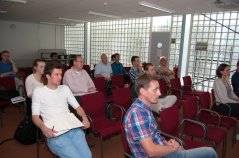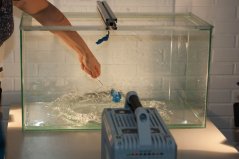
Nieuws
Possibilities of the two new high-speed camera systems
On 27 September Florian Muijres and Remco Pieters presented the range of possibilities of the two new high-speed camera systems, to a broad public of researchers gathered in Zodiac at Wageningen University & Research (WUR). Shared Research Facilities (CAT-AgroFood) recently purchased these instruments and provides access to these new facilities to researchers of WUR as well as to researchers from companies and other knowledge institutes.
The high-speed cameras can be used for studying multiple processes: either those occurring with many changes at high frequency in a small time frame, or those taking place under low light conditions. The technical details and potential practical applications of the two recording systems were outlined. The possibility to record videos in three dimensions and under low light conditions offers opportunities for the detailed analysis of the movements of small animals, fungi and mosses, and for studying non-living materials as fluids, crumbs, droplets, balloons, breaking crackers, etc. Further details can be found in the presentations.

Florian Muijres showed some results of the latest research on the flight behaviour of Drosophila flies and malaria mosquitos. The flight behaviour of these insects can be analysed meticulously with the new systems, including the exact way insect move their wings in order to fly, their strategies of taking turns in flight and their avoidance of fly swappers.
Subsequently, Cees Voesenek gave a presentation on the advanced biomechanical research of the swimming behaviour of zebrafish larvae. Body position, muscle use and contractions were made visible in the small transgenic animals with fluorescent GFP proteins.. With the data generated this way, computer models of the exact body movements of the fish larvae in three dimensions can be constructed.

Finally, Remco Pieters together with a volunteer gave a live demonstration of the High-Speed Intensified Imaging System using sharp needles, scissors and a balloon filled with water. The resulting images showed the subsequent events in spectacular detail!
The seminar was concluded with an informal discussion, where the guests had the opportunity to discuss their specific questions with the experts. The high-speed cameras are placed at the Experimental Zoology Group. If you are interested to know more about the high speed cameras or other equipment of WUR, please contact Shared Research Facilities.